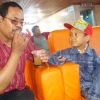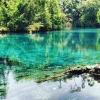Insects playing an important role in nature. They are function as a predator, parasitoid, pollinator, scavenger and other. The pollinator insects including order Dipteran such as Syrphidae (hover flies) and Muscidae; Hymenopteran (Apis spp or honey bee) and Lepidopteran including all of the butterflies species.
Bantimurung-Bulusaurung National Park namely The Kingdom of Butterfly in South Sulawesi is the beautiful karst mountain and rain forest which spreads from Maros to Pangkep districts (4.9000° S, 119.7500° E). Not only suitable habitat for butterfly, Bantimurung-Bulusaraung National Park is found to be the natural habitat for predatory insects from Coleopteran, Hemipteran, Hymenopteran and Dipteran orders (Sri Nur Aminah Ngatimin and Syatrawati, 2010; Sri Nur Aminah Ngatimin, Annie P. Saranga and Junaedi, 2014). Flowering weeds can provide shelters or refugia to support the lives of predatory insects particularly during the extreme environmental condition as well as during non-growing seasons (Landis et al., 2000).
A few research about insects was done in Bantimurung-Bulusaraung National Park and have been published in international event such as : Flowering weeds as The Refugia for Predatory Insects (Journal Tropical Crop, Bogor Agricultural University, 2014), Two Formulation Artificial Diet for Larvae of Troides helena Linne (Lepidoptera : Papilionidae) (International Journal of Science & Technology Research, 2014) and A Preliminary Study of Graphium androcles Boisduval (Lepidoptera : Papilionidae) (poster presenter in 4th SUIJI International Symposium, 2014).
Insects and plant especially flowering weeds has a strong relationship. Flowering weeds to be bio-resources for insects. They were prepare nectar, pollen and extrafloral nectar for predatory insects as the natural enemies against pest insects. For immature stage, bark or root surface of flowering weeds suitable for protect them from extreme condition (on the dry and rainy season). Yes off-course, the presence of predatory insects in nature will decreasing application of synthetic insecticides and keep the agricultural product safety for the human life.
As the dominant pollinator insects in Bantimurung-Bulusaraung National Park, commonly butterflies are often used as bio-indicators ofecosystem health and as surrogates for overall biodiversity. Sensitivity to changes inmicroclimate and habitat make them particularly good indicators for monitoring of natural areas undergoing change (Sisk et al., 1994; Erhardt, 1985; Kremen, 1992). As with any indicator taxa, the relationship between butterfly diversity and the diversity of other species is imperfect (Singer and Ehrlich, 1991; Schulze et al., 2004; Bonebrake and Sorto, 2009). However, butterflies have great potential as indicators for use in conservation efforts as their taxonomy, distributions, and natural history are better described than for any other insect taxa (Brown, 1997).
Based my research observation, butterflies catcher and deforestation is the factor decreasing population of butterflies, where butterfly~like all wild animals~ lose their habitat. While much more should be done by government and stake holder to stop deforestation. The one famous butterfly species is G. androcles. Adult G. androcles is very beautiful with wingspan reaching about 80 – 120 mm. Commonly females of G. androcles are relatively larger than males. The base of the upper wings is white with three black diagonal parallel stripes. The other half of the upper wings is black, crossed by two thin white stripes. The hindwings are white and black markings on the lower margin. The underside similar to the upside, but the white is partially greenish. The hind wings terminate in a very long tail which is the longest among all members of the relevant family of Papilionidae. Body is black with the white sides of the abdomen (Anonymous, 2011; Braby, 2000). High demands towards of G. androcles can increase capture rates from their natural habitats by local people. If it becomes excessive, this may threaten the survival of local population, even whole species.
Utilization of wild animals and plants included in Appendix II CITES is permitted only if the specimens is the results of captive breeding activities. In Indonesia, there are regulations about the trade and utilization of wild animals and plants, i.e. PP 7 and 8 year 1999; UU No. 5 year 1990 (accessible at http://www.dephut.go.id/index). Unfortunately, the beautiful G. androcles not including inside.
We must proud with the presence of butterfly and another beautiful insects in Bantimurung areas. To effortthe presence of them as bio-indicator of health environment around Bantimurung-Bulusaraung, activities such as butterfly ranching and captive breeding should be supported. Properly managed captive breeding can supply the high demands for G. androcles and other butterfly without capturing too many individuals from nature, because only a few individuals need to be taken to establish a captive breeding population.
^-*








